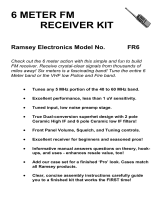Ramsey Electronics Walking Electronic Bug WEB1 User manual
- Type
- User manual
This manual is also suitable for
Ramsey Electronics Walking Electronic Bug WEB1 is a pocket-sized audio amplifier with built-in electret microphone designed to pick up sounds through direct contact with non-metallic surfaces. The amplified sound can be fed to any FM radio by plugging the WEB1 into the FM radio's antenna jack. Alternatively, the WEB1 may be plugged into any line level audio input such as "aux" input on a powered speaker. The WEB1 draws power from the FM radio's antenna jack or from the powered speaker audio input jack, thus eliminating the need for batteries.
Ramsey Electronics Walking Electronic Bug WEB1 is a pocket-sized audio amplifier with built-in electret microphone designed to pick up sounds through direct contact with non-metallic surfaces. The amplified sound can be fed to any FM radio by plugging the WEB1 into the FM radio's antenna jack. Alternatively, the WEB1 may be plugged into any line level audio input such as "aux" input on a powered speaker. The WEB1 draws power from the FM radio's antenna jack or from the powered speaker audio input jack, thus eliminating the need for batteries.




















-
 1
1
-
 2
2
-
 3
3
-
 4
4
-
 5
5
-
 6
6
-
 7
7
-
 8
8
-
 9
9
-
 10
10
-
 11
11
-
 12
12
-
 13
13
-
 14
14
-
 15
15
-
 16
16
-
 17
17
-
 18
18
-
 19
19
-
 20
20
Ramsey Electronics Walking Electronic Bug WEB1 User manual
- Type
- User manual
- This manual is also suitable for
Ramsey Electronics Walking Electronic Bug WEB1 is a pocket-sized audio amplifier with built-in electret microphone designed to pick up sounds through direct contact with non-metallic surfaces. The amplified sound can be fed to any FM radio by plugging the WEB1 into the FM radio's antenna jack. Alternatively, the WEB1 may be plugged into any line level audio input such as "aux" input on a powered speaker. The WEB1 draws power from the FM radio's antenna jack or from the powered speaker audio input jack, thus eliminating the need for batteries.
Ask a question and I''ll find the answer in the document
Finding information in a document is now easier with AI
Related papers
-
 Ramsey Electronics FR146 User manual
Ramsey Electronics FR146 User manual
-
 Ramsey Electronics FR6 User manual
Ramsey Electronics FR6 User manual
-
 Ramsey Electronics HR20 User manual
Ramsey Electronics HR20 User manual
-
 Ramsey Electronics HR40 User manual
Ramsey Electronics HR40 User manual
-
 Ramsey Electronics SR2 User manual
Ramsey Electronics SR2 User manual
-
 Ramsey Electronics FT146 User manual
Ramsey Electronics FT146 User manual
-
 Ramsey Electronics TT1 User manual
Ramsey Electronics TT1 User manual
-
 Ramsey Electronics CB1 CHATTERBOX User manual
Ramsey Electronics CB1 CHATTERBOX User manual
-
 Ramsey Electronics TT1 User manual
Ramsey Electronics TT1 User manual
-
 Ramsey Electronics FM100B User manual
Ramsey Electronics FM100B User manual
Other documents
-
Retekess TR626 FM/M User manual
-
Vectronics VEC-131K User manual
-
 Befaco Mixer Owner's manual
Befaco Mixer Owner's manual
-
 Ramsey UT5 User manual
Ramsey UT5 User manual
-
MFJ 9317K Owner's manual
-
 American QRP Club TinEar Construction Manual
American QRP Club TinEar Construction Manual
-
MFJ 9317K Owner's manual
-
 Befaco Mixer Assembly Instructions
Befaco Mixer Assembly Instructions
-
ELECRAFT K1 Owner's manual
-
Vectronics VEC-1292K Owner's manual

































